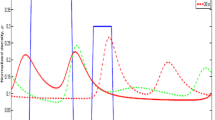Abstract
Despite the importance of urban traffic flows, there are only a few theoretical approaches to determine fundamental relationships between macroscopic traffic variables such as the traffic density, the utilization, the average velocity, and the travel time. In the past, empirical measurements have primarily been described by fit curves. Here, we derive expected fundamental relationships from a model of traffic flows at intersections, which suggest that the recently measured fundamental diagrams for urban flows can be systematically understood. In particular, this allows one to derive the average travel time and the average vehicle speed as a function of the utilization and/or the average number of delayed vehicles.
Similar content being viewed by others
References
D.C. Gazis, Traffic Theory (Kluwer Academic, Boston, 2002)
J. Esser, M. Schreckenberg, Int. J. Mod. Phys. B 8, 1025 (1997)
P.M. Simon, K. Nagel, Phys. Rev. E 58, 1286 (1998)
K. Nagel, Multi-Agent Transportation Simulations, see http://www2.tu-berlin.de/fb10/ISS/FG4/archive/sim-archive/publications/book/
M. Hilliges, W. Weidlich, Transpn. Res. B 29, 407 (1995)
D. Helbing, J. Siegmeier, S. Lämmer, Networks and Heterogeneous Media 2, (2007)
M. Cremer, J. Ludwig, Math. Comput. Simul. 28, 297ff (1986)
C.F. Daganzo, Transpn. Res. B 29, 79 (1995)
T. Nagatani, Phys. Rev. E 48, 3290 (1993)
D. Chowdhury, A. Schadschneider, Phys. Rev. E 59, R1311 (1999)
O. Biham, A.A. Middleton, D. Levine, Phys. Rev. A 46, R6124 (1992)
J.-F. Zheng, Z.-Y. Gao, X.-M. Zhao, Phys. Stat. Mech. Appl. 385, 700 (2007)
N.A. Irwin, M. Dodd, H.G. Von Cube, Highway Research Board Bulletin 347, 258 (1961)
R.J. Smock, Highway Research Board Bulletin 347, 60 (1962)
W.W. Mosher, Highway Research Record 6, 41 (1963)
Bureau of Public Roads, Traffic Assignment Manual (US Dept. of Commerce, Urban Planning Division, Washington, D.C., 1964)
T.J. Soltmann, Highway Research Record 114, 122 (1965)
K.B. Davidson, in Proceedings of the 3rd ARRB Conference, Part 1 (Australian Road Research Board, Melbourne, 1966), pp. 183–194
R.J. Smeed, Traffic Engineering and Control 8, 455 (1966)
K.R. Overgaard, Traffic Quarterly, 197 (1967)
J.M. Thomson, Traffic Engineering and Control 8, 721 (1967)
J.G. Wardrop, Traffic Engineering and Control 9, 528 (1968)
Y. Zahavi, Traffic Engineering and Control 14, (1972)
R. Akcelik, Australian Road Research 21, 49 (1991)
K.M. Lum, H.S.L. Fan, S.H. Lam, P. Olszewski, J. Transpn. Eng. 124, 213 (1998)
H.M. Zhang, Transpn. Res. Rec. 1676, 109 (1999)
H. Tu, Monitoring Travel Time Reliability on Freeways, Ph.D. thesis, Delft University of Technology, (2008)
C.F. Daganzo, Transport. Res. B 41, 49 (2007)
N. Geroliminis, C.F. Daganzo, Transpn. Res. B 42, 759 (2008)
N. Geroliminis, C.F. Daganzo, Macroscopic modeling of traffic in cities, TRB 86th Annual Meeting, Paper #07-0413, Washington D.C. (2007)
C.F. Daganzo, N. Geroliminis, An analytical approximation for the macroscopic fundamental diagram of urban traffic, accepted for publication (2008)
J.W. Godfrey, Traffic Engineering and Control 11, 323 (1969)
R. Herman, I. Prigogine, Science 204, 148 (1979)
R. Herman, S. Ardekani, Transportation Science 18, 101 (1984)
M. Eichler, C.F. Daganzo, Transportation Research B 40, 731 (2006)
D. Helbing, Rev. Mod. Phys. 73, 1067 (2001)
D. Helbing, M. Treiber, A. Kesting, M. Schönhof, Theoretical vs. empirical classification and prediction of congested traffic states, Eur. Phys. J. B, accepted for publication (2009), see e-print http://arxiv.org/abs/0903.0929
G.B. Whitham, Linear and Nonlinear Waves (Wiley, New York, 1974)
R. Hall, Queueing Methods for Service and Manufacturing (Prentice Hall, Upper Saddle River, NJ, 1991)
D. Helbing, J. Phys. A: Math. Gen 36, L593 (2003)
D. Helbing, A. Mazloumian, Operation regimes and slower-is-faster effect in the control of traffic intersections, submitted (2008), see e-printhttp://arxiv.org/abs/0903.0926
D. Helbing, T. Seidel, S. Lämmer, K. Peters, in Econophysics and Sociophysics, edited by B.K. Chakrabarti, A. Chakraborti, A. Chatterjee (Wiley, Weinheim, 2006), p. 552
Author information
Authors and Affiliations
Corresponding author
Rights and permissions
About this article
Cite this article
Helbing, D. Derivation of a fundamental diagram for urban traffic flow. Eur. Phys. J. B 70, 229–241 (2009). https://doi.org/10.1140/epjb/e2009-00093-7
Received:
Revised:
Published:
Issue Date:
DOI: https://doi.org/10.1140/epjb/e2009-00093-7




